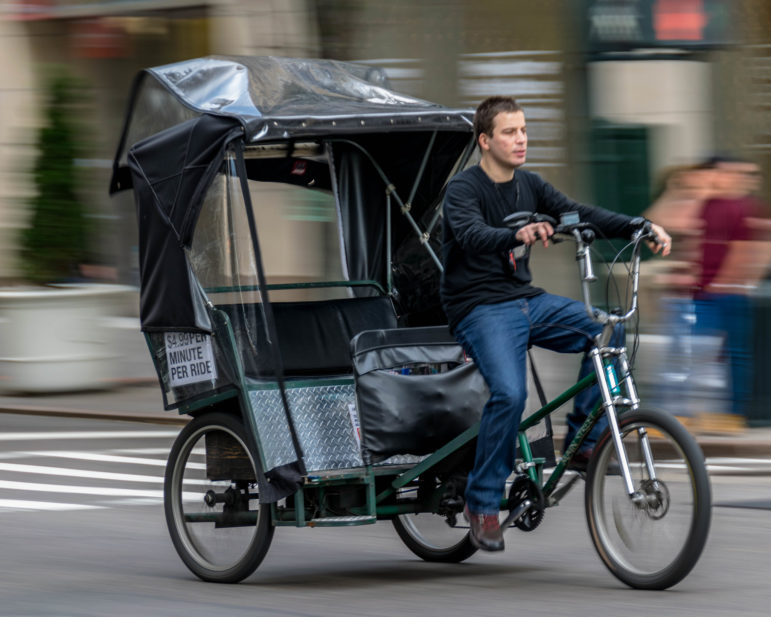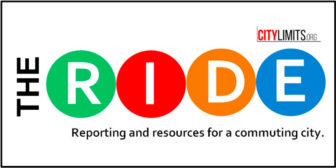
Doug Davey
As Albany considers broadly legalizing e-bikes and e-scooters, some pedicab drivers are hoping changes in state and local law will allow them to use pedal assistance.
Update: the bill to legalize the use of e-bikes and e-scooters on the state level was passed by the State Senate on Wednesday, then approved by the State Assembly on Friday.
As state lawmakers head into the final days of this year’s legislative session, one bill reportedly slated for a vote this week is a proposal from State Sen. Jessica Ramos and Assemblymember Nily Rozic to legalize the use of e-bicycles and e-scooters under New York state law—potentially paving the way for New York City to alter its own rules regarding the vehicles, hailed by advocates as an eco-friendly transit alternative that could help residents move more easily through an increasingly congested city.
While Mayor Bill de Blasio modified city rules last spring to more clearly legalize the use of pedal-assist e-bikes, other types—those that use a throttle, or ones that can operate without the driver pedaling—are still illegal. The NYPD continues to arrest and seize illegal e-bikes from the largely-immigrant drivers who work in the burgeoning food-delivery business, though the de Blasio administration has said it’s “open to further clarification” from Albany on how to regulate the popular vehicles.
Also hoping to be included in e-bike legalization: many of the city’s pedicab drivers, who say allowing them to legally utilize some form of motorized bicycle could help transform the industry from Central Park tourist novelty to legitimate transit option for New Yorkers making short-distance trips. Though pedal-assist e-bikes are legal in New York City, they’re banned from use by pedicab drivers thanks to city regulations passed more than a decade ago that require for-hire rickshaws be “solely propelled by human power.” That ban—the result of lobbying by the taxi industry at the time, according to advocates—continues to stifle the potential of the pedicab and drivers’ earning power, they say.
“I know that I can easily compete with Uber if they allow me to have electric-assist, and I can get people to wherever they want a lot faster than Ubers or cabs,” says Ibrahim Donmez, a longtime pedicab activist who drove one for a living for more than a decade.
Pedicab drivers face hefty fines
There are more than 800 drivers and businesses in the city with active pedicab licenses, data shows. In reality, those who work in the industry say many pedicab drivers already use some kind of electric-assisted bike—albeit against city rules—resulting in crackdowns similar to those experienced by food delivery drivers, and in pedicabs being seized by police. Drivers caught using a motorized bike can be fined up to $500 for the first violation.
“How is it that a pedicab that goes 10 to 15 miles an hour [is] confiscated based on Vision Zero policy?” Donmez says. “I find cars a lot more dangerous.”
Drivers in favor of allowing pedicabs to legally utilize e-bikes point to a number of potential benefits: it would allow them to more easily maneuver through stop-and-go midtown traffic, an important skill, since for-hire pedicabs are banned from using the city’s bike lanes. E-assist allows drivers to offer more rides per day without getting physically exhausted—increasing their earning power—and would let aging drivers remain in the business longer, as well as open the industry up to others looking to make a living.
“Most of us are recent immigrants,” says Eric Zoundi, an industry advocate who’s been driving a pedicab since 2012, when he came to New York as an international student and asylum seeker from Burkina Faso, and found “limited employment options.” Driving a pedicab helped him pay his way through school at Baruch College, he says, where he did his capstone project on pedicab industry regulations.
“Authorizing pedicabs to have the e-assist will make it possible for more employment seekers in the city to be able to carry passengers across town, make a living and pursue their dreams,” Zoundi testified during a State Senate hearing on Ramos and Rozic’s e-bike bill earlier this month.
Pointing to Austin
Others see similar opportunity in electric-assist pedicabs. Jeffrey Thomashow, an urban mobility entrepreneur, points to cities like Austin, Texas, where pedicabs are a well-used transit option in the congested downtown area. Last year, Austin launched a pilot program to allow a number of electric-powered pedicabs to operate, with the potential of making their use permanent.
“It’s an incredible product with a bad brand,” Thomashow says of pedicabs in New York, where they’re often regarded as high-priced tourist traps. He set out to change that in 2017, when he co-founded HOST—short for “hop on, short trips”—with the goal of using pedicabs to chauffeur people on short rides around town that are “too far to walk, and too close to get in a cab and sit in traffic.”
HOST analyzed Taxi and Limousine Commission data and found that 28 percent of yellow taxi trips made between July and December of 2016 travelled a distance of less than one mile, gas-fueled rides that could be better performed by zero-emission pedicabs, Thomashow argues. For two weekends in 2017, HOST offered free pedicab rides to people in the East Village—”people loved it,” Thomashow says—but the company is no longer in operation, citing the city’s ban on e-assist pedicabs as a main hurdle.
“For a business, we said we’re a little early,” Thomashow says. “The legislation really does need to change in New York City.”
Even if the state legislature legalizes e-bikes this week, the city would need to take separate action to lift its existing ban on their use by for-hire pedicabs. City Councilman Rafael Espinal, who’s helped lead the fight to legalize e-bikes in the city, says he’s sympathetic to the pedicab’s plight.
“Pedal-assist bicycles would allow them to do their job more efficiently, and be able to open up the market,” he says, adding that he “will work to assert that pedicabs are part of that conversation” once the state law has passed.
Mayor de Blasio’s office said it, too, is awaiting state action.
“Should the state pass this legislation, we would examine what types of pedicabs would be allowed on our streets. Safety will always be our top concern,” de Blasio Spokesman Seth Stein said in a statement.
Some drivers diverge
But some within the pedicab industry are less enthusiastic about the potential change. Gregg Zuman, a principal at the pedicab company Revolution Rickshaws, says he would like to see the city allow for-hire pedicabs to utilize pedal-assist bikes, which require the rider to pedal in order to activate the motor. These are currently legal in the city, just not for pedicabs. But he’s wary about allowing the use of e-bikes that require no pedaling, and which can be propelled by motor alone.
“To me, I think a bicycle is something that’s inherently powered by a person. Once you remove the person from the power, you have a vehicle,” he says. “You’re now in a whole different situation which requires a different set of behaviors, a different set of safety standards.”
Bobby Friese is another longtime pedicab driver who thinks e-bikes should be accessible for riders with a disability or injury, as well as the elderly. But he worries that allowing e-bikes and e-scooters to use the city’s bike lanes could make those spaces “inhospitable” to those on non-motorized bikes, and discourage people who might otherwise take up cycling from doing so.
“I really think they should be completely void from the bike lanes,” he says, adding that he’s also concerned about the environmental impact posed by the growing popularity of e-bikes and e-scooters, predicting a “huge problem with battery disposal in the future.”
Get the best of City Limits news in your inbox.
Select any of our free weekly newsletters and stay informed on the latest policy-focused, independent news.
“I believe we can do better for this planet. The American way is to rely on a motor to do everything—to brush our teeth, to lift our garbage can lids, to crush our pepper,” Friese says. While electric bicycles aren’t gas guzzlers, they still need to be plugged in. “It’s still a polluting machine. It just pollutes down the street at the power plant.”
Others, though, argue that getting New Yorkers to rely less on cars is key to the city’s transit future, and pedicabs could part of that.
“We can definitely be a part of alternative transit for last mile, first mile in this city,” says Zoundi. “But first we need to be electric-assist, and be more accepted on the street.”










2 thoughts on “Overlooked in Debate Over E-Bikes, Pedicab Drivers Hope for a Boost”
Pingback: The Monday Roundup: E-bike rebates, Major Taylor in the spotlight, a very long walk, and more - bet36体育开户
Is it a car or a bicycle? Its either one of the other. Bicycle is great exercise and great to move from place to place but commercially, is another ball game. This is my personal opinion.
I also do not know how to ride a non stationary bike yet.